As cherished companions, dogs depend on us for their overall health and well-being, and a fundamental element of their welfare involves ensuring they maintain an optimal weight. The escalating prevalence of obesity in dogs is a worrisome trend, leading to a multitude of health complications for numerous pets.
In this blog post, we will explore the signs of dog obesity, its root causes, and the crucial steps to address this issue in order to enhance the overall well-being of our beloved furry friends. Additionally, we’ll provide valuable insights on “How To Help Your Dog Lose Weight” to guide pet owners in promoting a healthier lifestyle for their canine companions.
Understanding Dog Obesity:
Canine obesity stands as a prevalent issue, mirroring the challenges faced by humans, with far-reaching consequences on the health of our furry companions. Much like in people, excess weight in dogs can become a breeding ground for a multitude of health complications. Dogs carrying surplus weight are particularly susceptible to developing severe conditions, including diabetes, arthritis, heart disease, and an overall reduced lifespan.
The ramifications of obesity extend beyond the visible physical burden, impacting internal organs and systems. For instance, the increased strain on joints due to excess weight can lead to the early onset and progression of arthritis, impinging on a dog’s mobility and quality of life. The risk of diabetes rises significantly, as obesity can disrupt insulin regulation and glucose metabolism in the body. Additionally, the cardiovascular system bears the brunt of the extra weight, elevating the chances of heart disease and related complications.
It’s not just the physical well-being that is at stake; obesity can drastically curtail a dog’s lifespan. The cumulative toll on various organs and systems shortens the overall life expectancy of an overweight dog, emphasizing the urgency of addressing this issue promptly.
Signs of Dog Obesity:
Weight Gain:
One of the most obvious signs of obesity in dogs is weight gain. Regularly monitoring your dog’s weight and body condition is crucial. If you notice a significant increase in weight without an apparent reason, it may be a cause for concern.
Loss of Waistline:
A healthy dog should have a noticeable waistline when viewed from above. If your dog appears to have a straight or rounded back, without a clear distinction between the ribcage and the hips, it might be a sign of excess weight.
Difficulty in Movement:
Obesity can impact a dog’s mobility. If your once-active pup starts to show reluctance or struggles to engage in physical activities like playing or going for walks, it could be due to the added strain on their joints and muscles.
Breathing Issues:
Labored breathing or panting can be a sign of obesity, especially during mild physical activity. Excess weight can put pressure on a dog’s respiratory system, making it harder for them to breathe comfortably.
Changes in Behavior:
Dogs may exhibit changes in behavior when they are carrying excess weight. This can include lethargy, irritability, or a decrease in overall enthusiasm. These behavioral changes can be indicative of the physical discomfort associated with obesity.
Causes of Dog Obesity:
Understanding the causes of obesity in dogs is crucial for prevention. Several factors contribute to the development of excess weight in our canine companions:
Overfeeding:
One of the primary causes of dog obesity is overfeeding. Providing too many treats, large portions, or an excessive number of meals can lead to an imbalance between calories consumed and calories burned.
Lack of Exercise:
Dogs, like humans, need regular exercise to maintain a healthy weight. A sedentary lifestyle can contribute to weight gain and various health issues. Lack of physical activity can be particularly problematic for certain breeds that are naturally more energetic.
Genetics:
Some dogs may be predisposed to obesity due to genetic factors. Certain breeds are more prone to weight gain, and owners of these breeds should be particularly vigilant about their pets’ weight management.
Medical Conditions:
Underlying medical conditions, such as hypothyroidism, can contribute to weight gain in dogs. It is essential to consult with a veterinarian if you suspect a health issue may be causing or exacerbating your dog’s obesity.
Preventing and Managing Dog Obesity:
Balanced Nutrition:
Providing a well-balanced and nutritionally appropriate diet is crucial for preventing obesity. Consult with your veterinarian to determine the appropriate type and amount of food for your dog’s breed, age, and activity level.
Regular Exercise:
Regular exercise is key to maintaining a healthy weight. Tailor your dog’s exercise routine to their specific needs, considering factors such as age, breed, and overall health. Engage in activities that promote both physical and mental stimulation.
Portion Control:
Be mindful of portion sizes and avoid overfeeding. Use measuring cups to ensure accurate serving sizes, and avoid giving in to those pleading puppy eyes for extra treats.
Regular Veterinary Check-ups:
Regular veterinary check-ups are essential for monitoring your dog’s weight and overall health. Your veterinarian can provide guidance on nutrition, exercise, and weight management specific to your dog’s individual needs.
Conclusion:
Identifying the indicators of canine obesity marks the initial stride in safeguarding the health and overall welfare of our beloved furry companions. Through comprehending the underlying causes, maintaining a watchful eye on weight management, and adopting proactive measures to avert obesity, we can actively promote an extended, healthier, and more vibrant life for our dogs. It is crucial to remember that a well-maintained weight contributes to a content and cheerful canine. As responsible pet owners, utilizing PetSavvy solutions, it becomes our duty to offer the necessary care and attention to ensure our canine friends remain in optimal condition.






